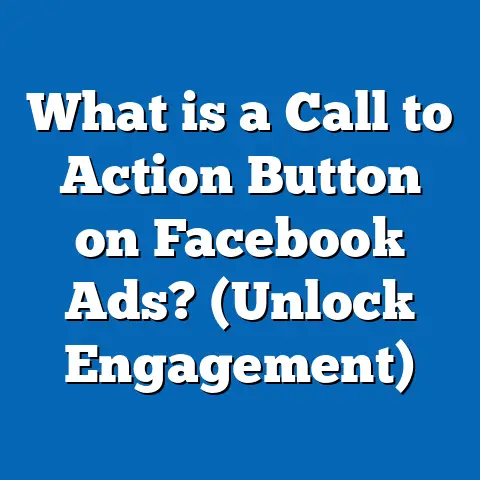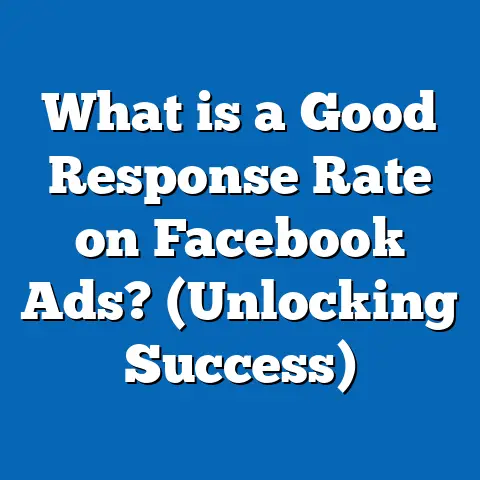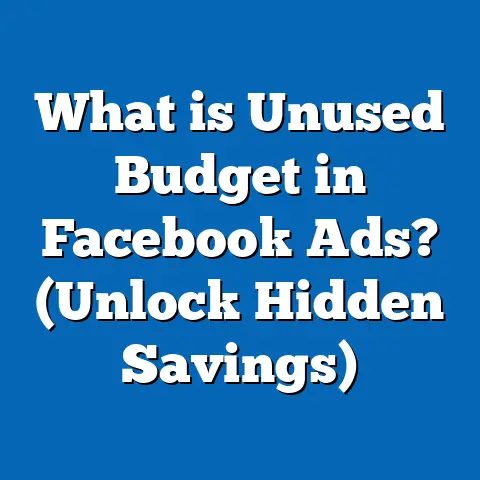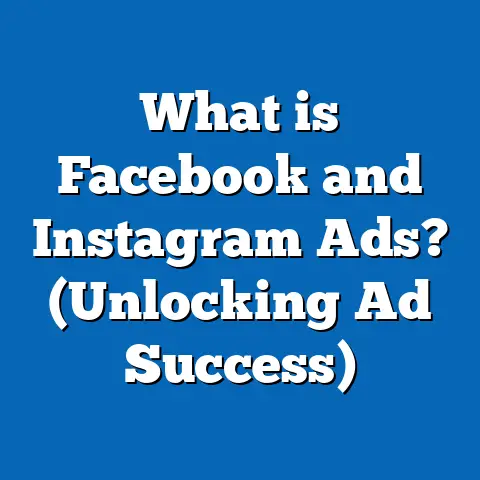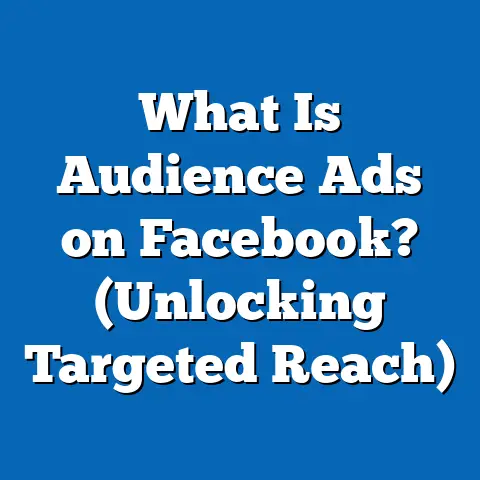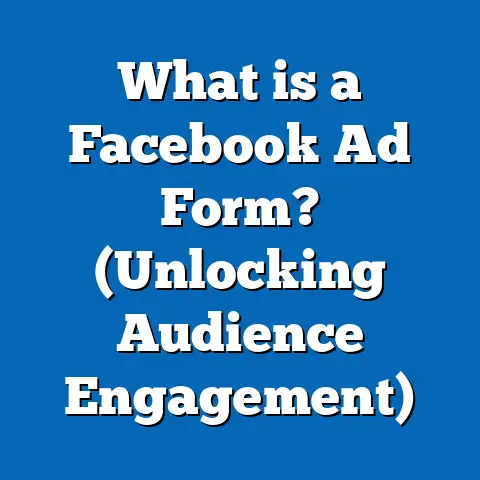What is a Link Click on Facebook Ads? (Unlocking Engagement Secrets)
What is a Link Click on Facebook Ads? (Unlocking Engagement Secrets)
Introduction: Have You Ever Thought About the Taste of Engagement?
Imagine savoring a meal with flavors that blend perfectly—each bite offering a new experience. Now, think about Facebook ads. Each click is like taking a bite of that meal. Some clicks are shallow tastes; others reveal deeper layers of flavor. But what exactly is a link click on Facebook ads? Why do marketers obsess over this metric? Understanding link clicks unlocks secrets to engagement that can significantly impact the success of your advertising campaigns.
Link clicks are often misunderstood or overlooked, yet they serve as a critical indicator of user interest and intent. For marketers and business owners, grasping what link clicks mean and how to measure them can be a game-changer in optimizing campaigns, boosting conversions, and maximizing ROI.
This article will break down everything you need to know about link clicks on Facebook ads—from fundamental definitions to advanced optimization techniques—backed by data, research, and real-world examples.
Section 1: Defining Link Clicks on Facebook Ads
What is a Link Click?
A link click occurs when a user interacts with an ad by clicking on a hyperlink embedded within it. This click directs the user to an external or internal destination:
- External: Your website, landing page, app store page.
- Internal: A Facebook event page, Messenger chat, or another Facebook property.
Important distinction: Not all clicks in an ad are link clicks. Clicking on the image or reacting to a post does not count unless it leads to a URL.
Why Are Link Clicks Important?
Link clicks are the gateway from awareness to action. They represent the user’s willingness to explore more about your product or service.
- Measure of Intent: A link click shows interest beyond passive viewing.
- Foundation for Conversions: Clicking through means users are one step closer to conversion (purchases, sign-ups).
- Optimization Metric: Advertisers can optimize based on link clicks to improve campaign performance.
Other Facebook Ad Click Types vs Link Clicks
Facebook tracks various click types:
| Click Type | Definition | Typical Use Case |
|---|---|---|
| Link Clicks | Clicking any URL/link in the ad | Drive traffic and conversions |
| Engagement Clicks | Likes, comments, shares | Boost social proof and brand awareness |
| Video Plays | Starting video playback | Increase video views |
| Post Reactions | Emoji reactions | Measure sentiment |
| Photo/Video Clicks | Enlarging images or viewing media | Content consumption |
Marketers focusing on action-driven goals should prioritize link clicks over other engagement types.
Section 2: How Does Facebook Track Link Clicks?
Technical Definition of a Link Click
Facebook counts a link click when:
- A user clicks the URL in the ad copy.
- A user clicks the call-to-action button (e.g., “Shop Now,” “Learn More”).
- A user taps any clickable link embedded in the ad.
Clicks on other parts of the ad—such as images or reactions—do not register as link clicks unless linked to a URL.
Tracking Tools for Link Clicks
Facebook Ads Manager
- Provides click metrics under the “Link Clicks” column.
- Shows click-through rate (CTR), cost per link click (CPC), and total clicks.
Facebook Pixel
- Enables tracking of user activity after clicking the ad.
- Measures conversions like purchases, sign-ups, or app installs.
- Helps assess link click quality by analyzing bounce rates and time spent on site.
Aggregated Event Measurement (AEM)
- With privacy changes (iOS 14+), AEM provides aggregated data for conversions post-click.
- Essential for understanding link click effectiveness amid tracking restrictions.
Data Insights: Average CTR and CPC Benchmarks
According to recent Facebook advertising benchmarks (2024 data):
| Industry | Average CTR (%) | Average CPC ($) |
|---|---|---|
| E-commerce | 2.6 | 0.45 |
| B2B Services | 1.8 | 1.20 |
| Finance | 2.0 | 1.50 |
| Education | 3.0 | 0.55 |
Understanding industry benchmarks helps set realistic goals for link click performance.
Section 3: Types of Link Clicks and Their Roles
Outbound Link Clicks: Driving Traffic Outside Facebook
Outbound link clicks lead users from Facebook to your owned digital assets like:
- Product pages
- Landing pages
- Blog posts
- Registration forms
These are crucial for direct response campaigns aiming at sales or lead generation.
Inbound Link Clicks: Navigating Inside Facebook
Clicks that lead users within Facebook properties such as:
- Event pages
- Messenger conversations
- Facebook Shops
Useful for engagement-focused campaigns that nurture leads inside Facebook’s ecosystem.
App Install Link Clicks
Clicks directing users to app stores for downloading mobile apps.
- Measured alongside installs for calculating cost per install (CPI).
- Critical for mobile app advertisers using Facebook’s app install campaigns.
Link Click Quality: What Makes a Good Link Click?
While volume matters, quality is critical:
- Landing Page Views: Users who stay and interact with your site.
- Bounce Rate: Low bounce means users find what they expect.
- Time on Site: Longer time suggests meaningful engagement.
Facebook offers optimization options for “Landing Page Views” which prioritize clicks that load fully instead of just raw link clicks.
Section 4: Deep Dive into Link Click Impacts on Campaign Success
Why Raw Link Click Numbers Can Be Misleading
High link click numbers don’t always translate into conversions if users bounce immediately after clicking.
- A campaign might get 1,000 clicks but only 50 conversions due to poor landing page experience.
- Tracking post-click behavior is essential for accurate ROI measurement.
Case Study: Improving Campaign Performance Through Landing Page Optimization
A mid-sized online retailer ran two Facebook campaigns:
- Campaign A optimized for link clicks only.
- Campaign B optimized for landing page views with a mobile-friendly landing page.
Results after one month:
| Metric | Campaign A | Campaign B |
|---|---|---|
| Link Clicks | 10,000 | 8,000 |
| Landing Page Views | 6,000 | 7,500 |
| Conversion Rate (%) | 1.5 | 3.5 |
| Cost per Conversion ($) | $15 | $9 |
Campaign B had fewer raw clicks but much higher quality engagement and better ROI.
Post-Click Metrics You Must Track
To truly understand the value of your link clicks:
- Bounce Rate: Percentage leaving without interaction.
- Pages per Session: Number of pages viewed per visit.
- Average Session Duration: Time spent on site.
- Conversions: Purchases, sign-ups, downloads.
Use these metrics alongside Facebook data for full picture analysis.
Section 5: Practical Strategies to Maximize Link Click Impact
Crafting Irresistible Calls-to-Action (CTAs)
Your CTA drives link clicks. Best practices include:
- Use action verbs (“Buy Now,” “Download,” “Sign Up”).
- Make benefits clear (“Get 20% Off Today”).
- Align CTA with landing page content.
Optimize for Mobile Experience
Since over 90% of Facebook users access via mobile (Statista, 2024):
- Ensure fast-loading mobile pages.
- Use responsive design.
- Simplify forms and checkout processes.
Use A/B Testing to Refine Ads
Test variables such as:
- Headlines
- Images/videos
- CTA buttons
- Ad copy length and tone
Analyze which combination drives higher-quality link clicks.
Retarget Users Who Clicked But Didn’t Convert
Create custom audiences of users who clicked links but did not complete your desired action. Retargeting ads can:
- Remind potential customers.
- Offer discounts or additional info.
- Increase conversion rates by up to 30% (Facebook Business data).
Section 6: Comparing Link Clicks Across Major Platforms
| Platform | How Link Click is Defined | Tracking Method | Unique Strength |
|---|---|---|---|
| Any clickable URL in ad | Pixel & Ads Manager | Detailed demographic targeting | |
| Google Ads | Click on search/display ad links | Google Analytics & conversion tracking | Intent-based keyword targeting |
| LinkedIn Ads | Click leading off platform | LinkedIn Insight Tag | B2B professional audience focus |
| Twitter Ads | Tweet link clicks | Twitter Pixel & Analytics | Real-time engagement |
Facebook excels in granular targeting combined with behavioral insights, making its link click data valuable for precise campaign optimization.
Section 7: Advanced Techniques for Optimizing Link Click Campaigns
Choosing the Right Optimization Goal: Link Clicks vs Landing Page Views
Facebook allows you to optimize your campaign delivery based on:
- Link Clicks: Maximize total clicks regardless of post-click behavior.
- Landing Page Views: Focus on users who wait for your page to fully load.
Choosing landing page views usually results in higher quality traffic but often at a higher CPC.
Utilizing Lookalike Audiences Based on Link Clickers
Create lookalike audiences from users who have clicked your links. This helps target new users with similar browsing behaviors and interests.
Section 8: Privacy Updates and Their Impact on Tracking Link Clicks
Impact of iOS 14+ and ATT Framework
Apple’s App Tracking Transparency (ATT) requires explicit user consent for tracking apps across websites and apps.
Effect on Facebook Advertising:
- Reduced visibility into individual user actions post-click.
- Less granular data on link click conversions.
How to Adapt Your Strategy
- Implement Facebook Conversions API alongside Pixel.
- Use aggregated event measurement.
- Focus on broader trends rather than individual-level data.
- Invest in first-party data collection strategies.
Section 9: Emerging Trends Shaping The Future of Link Click Engagement
AI-Powered Campaign Optimization
Facebook’s machine learning algorithms now predict which users are most likely to generate high-quality link clicks and conversions—allowing smarter bidding strategies.
Interactive Ad Formats
Formats like Instant Experience ads create immersive experiences inside Facebook before driving visitors out, improving both click quality and conversion rates.
Video + Link Combinations
Video content combined with clear CTAs has been shown to increase link click CTR by up to 20% compared to static images alone (Facebook internal data).
Section 10: Summary and Clear Takeaways
What You Should Remember About Link Clicks
- Link clicks show initial user interest by directing users from your ad toward an external or internal destination.
- They differ from other clicks by indicating intent rather than passive engagement.
- Quality is more important than quantity—track post-click behavior closely.
- Optimize your ads with strong CTAs and mobile-friendly landing pages.
- Use Facebook Pixel and retargeting strategies for better ROI.
- Stay updated with privacy changes impacting tracking.
- Leverage new technologies such as AI optimization and interactive formats.
Final Recommendations and Next Steps
- Review your existing campaigns focusing on link click data and post-click engagement metrics.
- Set up or audit your Facebook Pixel implementation ensuring accurate tracking.
- Test different campaign objectives like landing page views instead of just link clicks.
- Build retargeting campaigns targeting warm audiences who clicked but did not convert.
- Prepare to adapt tracking strategies based on privacy updates using Conversions API and aggregated measurement.
- Experiment with video + CTA combinations and Instant Experience ads to enhance engagement quality.
Mastering the concept of link clicks puts you firmly in control of your Facebook advertising success—turning mere interest into real business growth.

